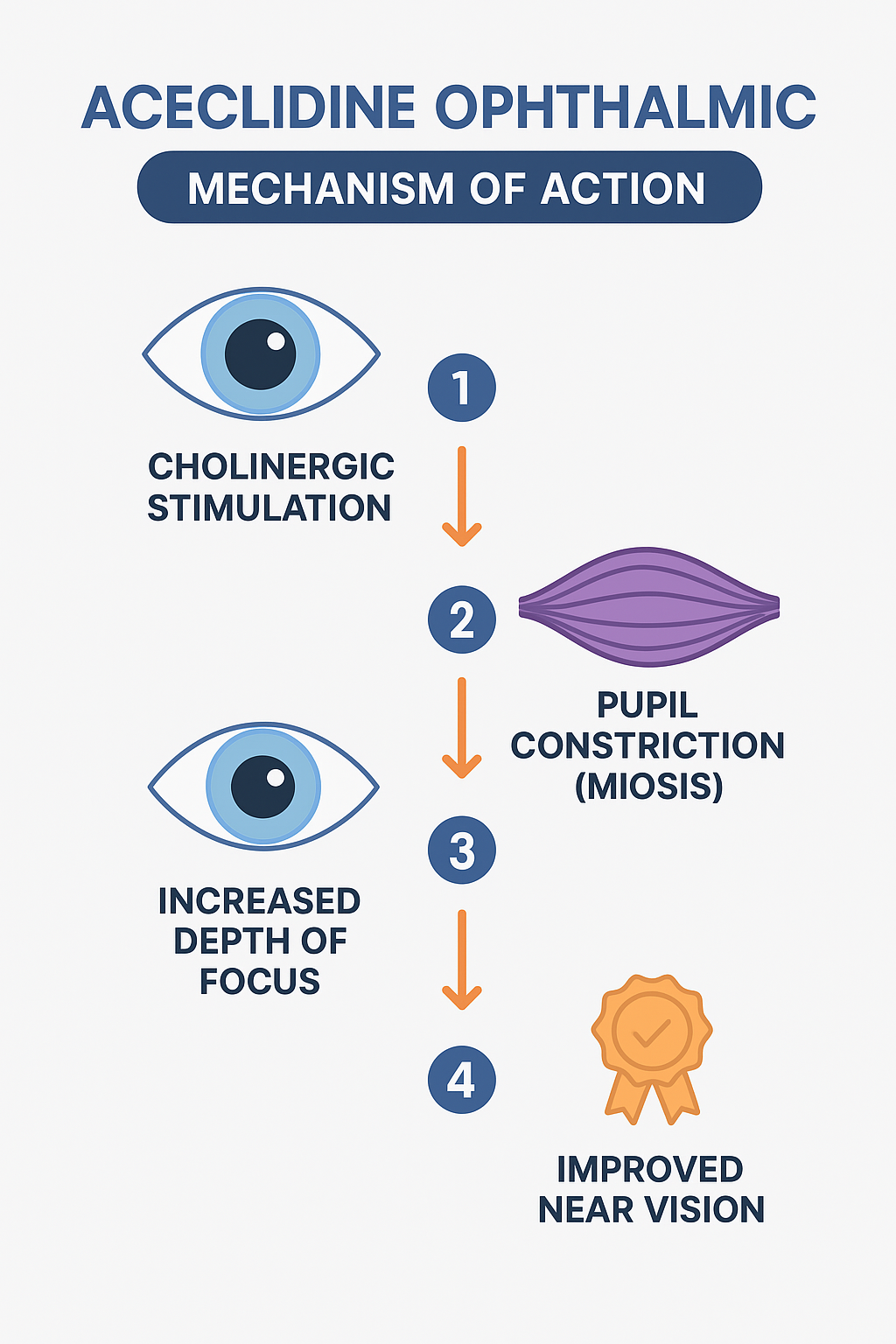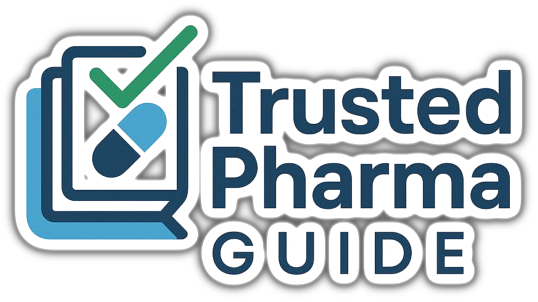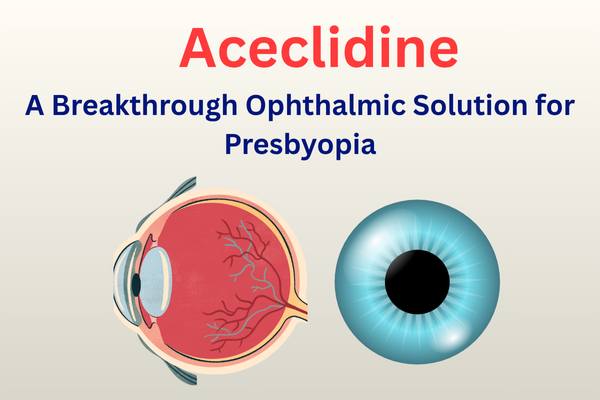Table of Contents
Introduction
As we age, one of the most common eye diseases we encounter is presbyopia – the gradual loss of the eye’s ability to focus on near objects. It usually begins to affect people in their early to mid-40s and worsens with age. Reading glasses have long been a solution, but medical science is now providing new options that go beyond corrective lenses. One such innovative treatment is Aceclidine ophthalmic, a drug in the class of cholinergic agonists.
Ophthalmic cholinergic solution has emerged as a promising therapy for managing presbyopia by improving near vision and depth of focus. In this blog, we will go into detail about what Aceclidine is, how it works, its medical uses, safety profile, benefits, and how it compares to conventional treatments.
What is Aceclidine ophthalmic Solution ?
Aceclidine is an ophthalmic medication in the class of cholinergic agonists. This means that it mimics the action of acetylcholine, a natural neurotransmitter, to stimulate receptors in the eye. When used in the form of eye drops, acetylcholine targets specific muscles that dilate the pupil and focus, thereby improving near vision. Unlike reading glasses or contact lenses that only provide external help, acetylcholine actually works within the eye. It does this by triggering natural physiological changes that help restore a person’s ability to see clearly up close.
Mechanism of Action:
To understand how Aceclidine can benefit patients with presbyopia, it is important to first understand the condition.
• Presbyopia occurs because the lens of the eye becomes less flexible with age, making it harder to focus on close objects.
• Normally, the ciliary muscle adjusts the shape of the lens for near and far vision. In presbyopia, this muscle becomes less efficient and the hardened lens cannot accommodate as effectively.
Here is where Aceclidine ophthalmic comes into play:
- Cholinergic Stimulation – Aceclidine activates cholinergic receptors in the eye.
- Pupil Constriction (Miosis) – The medication causes mild constriction of the pupil.
- Increased Depth of Focus – A smaller pupil increases the eye’s depth of field, much like a camera with a smaller aperture.
- Improved Near Vision – By enhancing the natural focusing mechanism, Aceclidine allows patients to see close objects more clearly without external lenses.
This mechanism is often described as creating a “pinhole effect,” where vision clarity is improved by limiting light scatter and focusing light more precisely on the retina.

Medical Uses
The primary and most studied medical use of Aceclidine ophthalmic is the treatment of presbyopia. Let us look at this in detail:
1. Presbyopia Management
- Aceclidine is designed to help adults who struggle with age-related near-vision problems.
- It can reduce or eliminate the need for reading glasses in many daily tasks such as reading books, using a smartphone, or working on a computer.
2. Potential Role in Other Eye Disorders
While its main application is in presbyopia, research suggests that cholinergic agonists like Aceclidine could also have roles in managing conditions where improved depth of focus or controlled pupil size may help. However, these applications are still under investigation.
Benefits
Patients who use Aceclidine ophthalmic solution may experience multiple advantages over traditional corrective lenses.
- Non-Invasive Alternative
- Provides a pharmaceutical option instead of surgical interventions like corneal implants or refractive surgery.
- Convenience
- Can reduce dependence on glasses, especially for reading or other near-vision tasks.
- Natural Vision Restoration
- Works within the eye to restore functionality rather than masking the issue with external devices.
- Fast-Acting Results
- Many patients report noticeable improvement in near vision within a short period after application.
- Better Quality of Life
- Reduces frustration from constantly switching between reading and distance glasses.
Side Effects
Like any medication, Aceclidine ophthalmic may cause side effects. Most are mild and temporary, but they should still be considered:
- Eye Redness or Irritation – Some users may experience mild discomfort.
- Headache – A common side effect due to ciliary muscle contraction.
- Temporary Blurred Vision – Usually resolves as the eyes adjust.
- Difficulty with Night Vision – Pupil constriction may reduce vision in low-light conditions.
Safety Considerations
- Patients with certain pre-existing eye conditions, such as uveitis or severe myopia, should consult an ophthalmologist before using Aceclidine.
- It is essential to follow the prescribed dosage to avoid complications.
- Long-term safety data is still being studied, so regular follow-up with an eye care professional is recommended.
Aceclidine vs. Traditional Treatments for Presbyopia
| Treatment Option | How It Works | Pros | Cons |
| Reading Glasses | External lenses magnify text | Simple, affordable, no side effects | Inconvenient, requires frequent use |
| Contact Lenses | Multifocal or monovision lenses | Clear vision, cosmetic advantage | Requires maintenance, may cause dryness |
| Surgery | Corneal or lens modification | Long-term solution, no daily medication | Expensive, invasive, surgical risks |
| Aceclidine Eye Drops | Stimulates ciliary muscle, constricts pupil | Non-invasive, convenient, restores natural focus | Temporary effect, mild side effects |
Aceclidine provides a middle ground — more convenient than glasses and less invasive than surgery.
Clinical Research on Aceclidine
Research studies have shown encouraging results regarding the effectiveness of this ophthalmic innovation in treating presbyopia. In clinical trials:
- Patients reported improved near vision within hours of application.
- Benefits often lasted several hours, covering most daily tasks.
- Safety profile was generally acceptable, with mild side effects.
These findings highlight Aceclidine as a viable option in the growing field of pharmacological solutions for presbyopia.
Future of Aceclidine in Eye Care
The development of Aceclidine ophthalmic reflects a broader trend in ophthalmology: using medications instead of mechanical devices to treat vision problems. As research continues, Aceclidine could become a widely prescribed option for middle-aged and older adults who prefer non-invasive solutions.
Potential areas of future development include:
- Combination therapies with other ophthalmic drugs.
- Extended-release formulations for longer-lasting effects.
- Expanded indications for other eye conditions.
Patient Experience and Lifestyle Impact
Many people who try cholinergic Agonist Drops report a noticeable change in their daily lives:
- No longer needing to carry reading glasses everywhere.
- Feeling more confident in social and professional settings.
- Improved efficiency in digital work environments where switching glasses is inconvenient.
This shows that Aceclidine is not just a medical treatment but also a quality-of-life enhancer.
How to Use Aceclidine Safely
- Prescription Only –The ophthalmic medication should be used only under the guidance of an eye care professional.
- Follow Dosage Instructions – Overuse may lead to complications such as eye strain or excessive pupil constriction.
- Avoid Driving at Night Initially – Until you know how the medication affects your night vision, use caution.
- Report Side Effects – Any persistent discomfort should be reported to your doctor.
Conclusion
Aceclidine ophthalmic is a revolutionary step in the treatment of presbyopia. As a cholinergic agonist, it stimulates the ciliary muscle and constricts the pupil, which increases the depth of focus and improves near vision.
Compared to reading glasses or surgery, This ophthalmic medication provides a convenient, non-invasive, and effective alternative. While it may not completely eliminate the need for corrective lenses in all situations, it offers significant freedom and confidence to patients seeking better vision.
As clinical research advances, Aceclidine ophthalmic may soon become a standard therapy for presbyopia, allowing millions of people around the world to restore natural near vision without relying on glasses.

